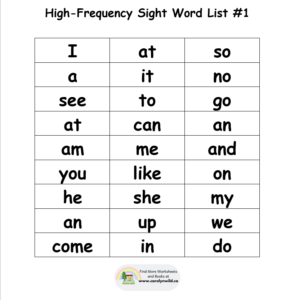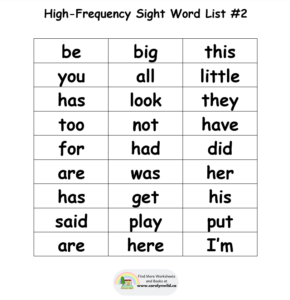
Here are some basic high-frequency sight word lists that can be downloaded for free. These words were taken from the Fountas and Pinnell, Dolch Word, and Fry Sight Word Lists.
Free Carolyn Wild Book Worksheets-click here!
The Wild Acres Books are all leveled using Lexile, ATOS, and other corresponding leveling programs for your convenience. These leveling charts are presented within the front matter of each carefully designed book. Carolyn Wild’s children’s picture books feature real photos and include emergent high-frequency words, decodable words, rhyming, math concepts, and many common beginner words. Look for the colourful picture dictionaries and cool science facts near the back of each emergent reader.
Carolyn has been busy creating worksheets and colouring sheets for each book to engage children in learning new words. These worksheets are available for free and more worksheets will be uploaded as time permits.
Copyright Terms:
All worksheets marked with “www.carolynwild.ca” are Copyrighted © All rights reserved. My worksheets are provided to you for your personal use. You are welcome to save the files on your computer and print off copies for yourself, your children, or your students. You may post pictures of your children or students using my worksheets on your blog, provided www.carolynwild.ca is properly credited and linked in the post. You can link directly to www.carolynwild.ca to share my files with others. You cannot host my worksheets on your own or on other sites. You cannot upload my pdf files to your server. You cannot alter or sell any of my worksheets. All files are for personal non‐commercial use only. You may NOT use my items for sale or profit. By downloading and printing my worksheets you agree to these copyright terms.
Suggestions and Activities for Use:
- Start with High-Frequency Sight Word List #1 and use 4 – 6 short easy words from the list to start.
- Practice the same words for 1 – 2 weeks.
- If your child needs more time, allow this before moving on. Every child learns at their own pace.
- Don’t move onto High-Frequency Sight Word List #2 until the child knows the words from List #1.
- Keep the lessons short, engaging, and fun.
- You can cut out the words, hide them, or pin them around the house or classroom.
- Play the Write the Room game and copy the words you see onto a little clipboard.
- Rainbow Writing involves the use of different coloured crayons. Trace the same word repeatedly in various colours until it looks like a rainbow.
- Print off the chosen list of words. Place inside a plastic page sleeve and use an erasable marker to trace over the words.
- Have pretend spelling tests and give encouragement or stickers for a job well done.
- Clap out the letter names and letter sounds. Each sound that you hear in a word is a Phoneme. It’s the smallest unit of sound that makes up a complete word.
- Clapping out syllables helps children notice and hear that words have parts.
- Print two sets of words or word lists and cut them up for a matching game.
- Place salt or play sand on a cookie sheet and write the letters and words on it with your fingers.
- Use clay or playdough to make the letters and words.
- Place the words in a bag, pillowcase, or empty plastic jar and take turns pulling them out and saying them.
- Write the words onto Popsicle sticks and keep them in a little cup. Pull them out one at a time and take turns saying them.
- Print the words out on different coloured paper or cards. Ensure that each word is on a different coloured piece of paper. It helps with visual learners.
- Print off a word list. Then find the same words in old newspapers and magazines and cut them out to make a collage. A collage describes the technique and the resulting work of art in which pieces of paper are arranged and stuck together.
- Look for the same sight words in the books you read. Then point them out and discuss them while you read together.
- Once you learn the words you can make a word wall or add magnets to the back of the words and stick them on the fridge.
- You can also make a scrapbook and keep the words in a jar or Ziploc bag.
- Children need lots of repetition to learn new words so keep the lessons short and practice daily.




